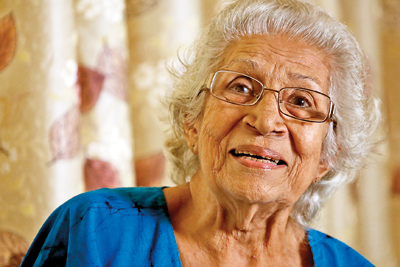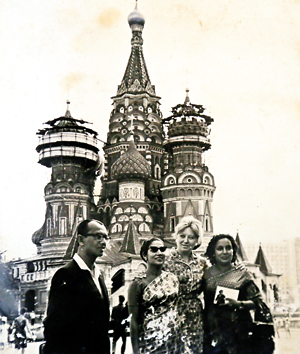From Europe to Ceylon, in the thick of the leftist movement

Barbara at home in Kotte. Pic by M.A. Pushpa Kumara
She was not a first-line Communist who fought for independence but someone who was initiated into the cause soon after, to take the struggle forward in England and also the fledgling nation state that was Ceylon.
It is to have a chat about old times that we meet 92-year-old charming Barbara Seneviratne in her home down Beddagana Road, Kotte, on Wednesday.
She regales us with tales of Marxist activism in the heart of London, over kalu dodol and tea. It was while working at Harrods, having accompanied her husband Dr. Yasalalaka Seneviratne to England, that she got into the thick of it, with a small group which included Wilfred (Willa) Wickramasinghe, Ratnasiri Wickramanayake and Neelan Tiruchelvam, coming under the powerful influence of Edith Finch Russell, the fourth wife of Bertrand Russell, 3rd Earl and British philosopher, social critic and political activist who was a Nobel Laureate.
Debating left-oriented ideas with these intellectuals, Barbara attended meetings of a Sunday at Hyde Park Corner or at Ceylon House and joined in protest marches against the atom bomb across Europe.
It would be an exotic sight – Barbara clad in saree selling the ‘Daily Worker’ espousing the cause of the Communist Party of Great Britain. To sell the two-page tabloid costing a few pence and dealing with issues such as war and living conditions of workers, her beat was near St. Pancras Church in Central London.
Those were the 1960s and she jokes that the easiest way to get a seat on the tram was to board it with a bundle of ‘Daily Worker’, similar to the ‘Forward’ published in Ceylon by the Communist Party. Staid Britons, suspicious of all that came under the red banner, would glance at the paper and quickly vacate their seats.
She also joined anti-atomic bomb protests in Europe and remembers how elderly ladies camped out in the open.
Back home in Ceylon from England in 1959, Barbara worked closely with Pieter Keuneman and his wife Maud and other stalwarts of the leftist movement including D.E.W. Gunasekara.
Do you know that the left movement had “very strong women” at the helm, she says, bringing up names such as Ponsinhamy, Lady Kularatne, Doreen Wickramasinghe, Vivienne Gunawardene and Nanda de Silva.
Why is it that there are no such women in Parliament now? They should be brought in through the National List, she says, reiterating that men were blocking it.
In Ceylon, she immersed herself in the Sri Lanka Russia Friendship Society which had evolved from ‘Friends of Russia’ of the 1940s.
To the first and second General-Secretaries G.D.C. Weerasinghe and Peter Jayasekera, she was Assistant Secretary, and they would take documentaries such as ‘Mother’, ‘Cranes are Flying’ and even ‘Swan Lake’, across the country. “We went to villages, put up screens and people came in their numbers.”

Barbara second from left at Moscow’s Red Square
She did visit the Soviet Union and counting on her fingers, “at least six or seven times”. Then she pulls out albums with large sepia-toned photographs at Moscow’s Red Square, the courthouse etc. The first page has details all in Russian and she says with a tinge of regret that she could speak Russian then but not now.
Getting back to her introduction to Marxism, the influence of Yasalalaka, whom she met as a young nurse at the Colombo General Hospital (CGH) was too strong to resist. Every evening, they would sit in the garden and speak not of love, but “heavy stuff” based on the writings of Karl Marx and Vladimir Lenin, in books borrowed from the Thinkers’ Library.
The inequalities of life she experienced as a child. Her father Gerard Ernest de Silva faced discrimination when Fentons, the company for which he was working, sent him to India to study electronics engineering. When he fell ill, he had been admitted to the Madras Civil Hospital — not to the ward where the white Britons were being treated but to the natives’ “pariah” ward.
Having heard his complaints, Chief Matron Evelyn Cooke had moved him to the British ward. Gerard fell in love with Evelyn who was from Ireland and married her.
When he returned to Ceylon in 1926 it was a different kind of discrimination – “Get out,” he was told by his father and when Barbara was born her grandmother had been categorical that “paradeshi ayata ayakam karanne ne” (that she would not become a nanny to foreigners). Those were the late 1920s when hostility towards the colonial power was running high.
Tragedy hit Barbara at the tender age of three when her mother died of cancer.
With Fentons having the responsibility of electrifying the road network, Gerard would journey to the rural areas but he never left his little girl behind, taking her, secure between his arms, seated on the petrol tank of his motorcycle.
“Dadda was a boxer and hunter,” reminisces Barbara and his gun was strapped to the mo-bike wherever they went, winning him the sobriquet ‘Thuwakku Silva’. They did not have photographs on the walls of their home but guns.
He would check out the smallest home and keep Barbara there to play with the children and share their humble fare, mostly a vegetable like bandakka (ladies’ fingers) cooked kirata and rice.
Now many moons later, away from the excitement of meetings and marches, Barbara strolls in her garden, reads leftist literature and spends time with her beloved Christy, a cross between a Daschund and a Labrador and three cats, Sultana, Kitty and Tommy.
It is time for us to leave but not before being presented with many books on the leftist movement, while on an earlier visit it was a large patchwork picture of a red cockerel created by her.


